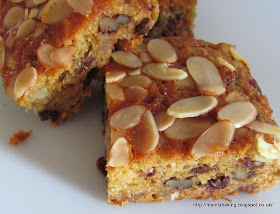As I was so disappointed with the cake, I decided not to even write a blog post about it, but you can follow the link above, if you want to know what to avoid!
That left me with roughly half a tin of caramel to use, and I also had some really good quality Sainsbury's gluten-free rolled oats that I wanted to compare with ALDI porridge oats and Tesco everyday value oats. Obviously, finding a recipe for caramel flapjacks was a priority, but it had to be a recipe that used the amount of caramel available.
It didn't take long to find this Annie Bell recipe for Salt Caramel Flapjacks. I was a little flabbergasted by the amount of butter, but I've cooked enough of Annie's recipes to trust her, especially as I was a little short on the amount of caramel needed. I had to use unsalted butter for the recipe, so added extra salt, in the form of 1 teaspoon of vanilla flavoured salt I happened to have in the store cupboard.
The recipe was simple to follow and quick to put together and cook. I cut the finished flapjacks into 16 portions - 25 seemed ridiculously small, although they would have been less calorific per portion! The results were absolutely delicious; my only criticism of the flavour was that I couldn't taste the salt. If (or, more likely, when) I make them again I will increase the amount of salt added. The flapjack was chewy and fudgy flavoured, and very rich. They were perhaps slightly on the crumbly side, but I think a few minutes extra baking will take care of that.
 As for the oats - the gluten-free oats were miles ahead in quality - they were whole grains rolled flat, to make large crisp flakes. The Tesco everyday value oats were next in quality, with smaller, less crisp flakes ( I have to say that I've been using these for baking for years, with no complaints about the results). The ALDI porridge oats were very small pieces of flake, which probably make great porridge, but were too fine to give a good result if used on their own in baked goods. I think in future I will use a mixture of the Tesco everyday value and the gluten-free oats to improve the texture of things such as biscuits and flapjacks. But for things like cakes, where the coarser texture isn't as important, and perhaps not even necessary, I'll continue with just the Tesco oats.
As for the oats - the gluten-free oats were miles ahead in quality - they were whole grains rolled flat, to make large crisp flakes. The Tesco everyday value oats were next in quality, with smaller, less crisp flakes ( I have to say that I've been using these for baking for years, with no complaints about the results). The ALDI porridge oats were very small pieces of flake, which probably make great porridge, but were too fine to give a good result if used on their own in baked goods. I think in future I will use a mixture of the Tesco everyday value and the gluten-free oats to improve the texture of things such as biscuits and flapjacks. But for things like cakes, where the coarser texture isn't as important, and perhaps not even necessary, I'll continue with just the Tesco oats.I'm just in time to submit this recipe to this month's Tea Time Treats challenge, which is to produce food suitable for a bonfire night party. TTT is a cooking challenge hosted alternately by Karen of Lavender and Lovage, and Jane of The Hedge Combers, who is this month's host.















